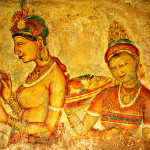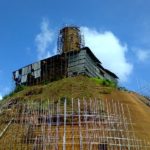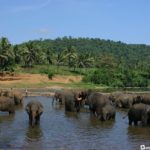Kandy is very popular due to the annual pageant known as the Esala Perahera in which one of the inner caskets used for covering the tooth relic of Buddha is taken in a grand procession through the streets of the city. This casket is taken on a royal tusker. The procession includes traditional dancers and drummers, flag bearers of the provinces of the old Kandyan kingdom, the Nilames (lay custodians of temples ) wearing their traditional dresses, torch bearers and also the grandly attired elephant.
The city, now a UNESCO World Heritage Site, lies 205 km north of the current capital Colombo in Sri Lanka’s North Central Province, on the banks of the historic Malvathu Oya. From the 4th century BC, it was the capital of Sri Lanka until the beginning of the 11th century AD. During this period it remained one of the most stable and durable centers of political power and urban life in South Asia.
The ancient city, considered sacred to the Buddhist world, is today surrounded by monasteries covering an area of over sixteen square miles (40 km²). Anuradhapura is also significant in Hindu legend as the fabled capital of the Asura King Ravana in the Ramayana. It is said that King Pandukabhaya made it his capital in the 4th century BC, and that he also laid out the town and its suburbs according to a well organised plan. He constructed a reservoir named Abhayavapi. The city had some of the most complex irrigation systems of the ancient world, situated in the dry zone of the country the administration built many tanks to irrigate the land. Most of these tanks still survive.
Major attractions of the city include the largest and best preserved cave temple complex of Sri Lanka, and the Rangiri Dambulla International Stadium, famous for being built in just 167 days. The city also boasts to have the largest rose quartz mountain range in South Asia, and the Iron wood forest, or Namal Uyana.
Ibbankatuwa prehistoric burial site near Dhambulla cave temple complexes is the latest archaeological site of significant historical importance found in Dambulla, which is located within 3 kilometers of the cave temples providing evidence on presence of indigenous civilisations long before the arrival of Indian influence on the Island nation.
Sigiriya may have been inhabited through prehistoric times. It was used as a rock-shelter mountain monastery from about the 5th century BC, with caves prepared and donated by devotees to the Buddhist Sangha. The garden and palace were built by King Kasyapa. Following King Kasyapa’s death, it was again a monastery complex up to about the 14th century, after which it was abandoned. The ruins were discovered in 1907 by British explorer John Still.
Thera Mahinda came to Sri Lanka from India on the full moon day of the month of Poson (June) and met King Devanampiyatissa and the people, and preached the doctrine. The traditional spot where this meeting took place is revered by the Buddhists of Sri Lanka. Therefore in the month of Poson, Buddhists make their pilgrimage to Anuradhapura and Mihintale.
From ancient times a large number of large steps were constructed to climb Mihintale. It is stated that King Devanampiyatissa constructed a vihara and 68 caves for the bhikkhus to reside in. At Mihintale there gradually grew a number of Buddhist viharas with all the dependent buildings characteristic of monasteries of that period.
The city is popular for excellent opportunities for surfing and turtleswhere one comes across turtles everywhere in the water.
The bus stand ,train station and police station are centered in the city while restorents arearounf them .Weligama and narigama are the close villages to hikkaduwa.
The town really comes alive in April for the Sinhalese and Tamil New Year, and it is difficult to find accommodation as Sri Lankans holiday in the region during this period. The festive season starts on April 1st annually in a ceremonial manner. Main attractions during April season include the numerous motor racing and horse racing events. Motor racing comes alive with the Mahagastotte and Radella Hill Climbs, the former being run since 1934.
One of the distinctive features of Nuwara Eliya’s countryside is the widespread growing of Tea plantation, vegetables, fruit and flowers usually associated with temperate Europe. This “Little England” is covered with terraces growing potatoes, carrots, leeks, and roses, interspersed with tea bushes on the steeper slopes.
Habarana is a popular tourist destination for safari lovers as it is the starting point for safaris in the nearby Habarana jungle and the Minneriya sanctuary which is heavily populated by elephants. Elephant back riding is also an attraction in this small city. Habarana is situated nearby to the ancient rock fortress and castle/palace ruin of Sigiriya and is situated on the main road from Colombo to Trincomalee, Polonnaruwa and Batticaloa. The population of the city is expected to be in the area of 5000-10,000. The area has some of the best hotels in the country and the greenery and wild life has added value, making the location attractive for tourists.
The open parkland attracts birds of prey such as White-bellied Sea Eagle and the wetlands have Waders, Painted Storks, and the rare Black-necked Stork.Landbirds of course are in abundance, and include Sirkeer Malkoha, Indian Peafowl and Sri Lanka Junglefowl.







